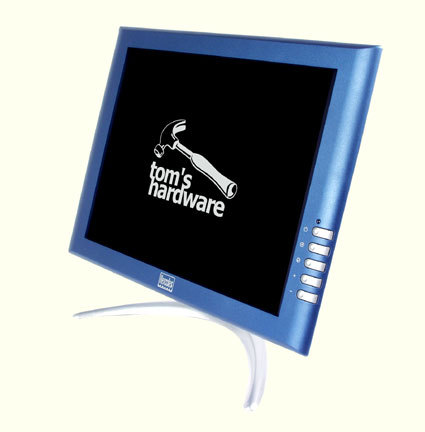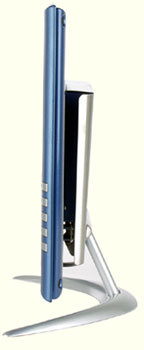Comparison Of 15" LCD Monitors - Part I
Hercules ProphetView 720
At the opposite end of the spectrum from the Belinea 10 15 35 is the ProphetView 720. While the former is outstanding because of the quality of its panel, the latter is much more modest, although its specifications might make you think the contrary. On the other hand, the former's design is rather spartan, while the ProphetView is sleek and sexy. This helps it seduce customers who are torn between a dozen different models on display at a store. It won't hurt to admit, just this once, that the Hercules' slick exterior makes up for its technical shortcomings. True, it's an entirely subjective judgment, but all the editorial staff here at THG agree that this TFT, the most attractive one available, is our favorite.
There's nothing ugly about the ProphetView 720 - even the standard base has been replaced by the designers with a silver half-moon. We were also highly impressed by how thin the panel is - less than two centimeters! Considering this thinness, its only drawback is that you can't hang it up on a wall.
But all these snazzy extras shouldn't distract us from our true goal of finding out whether the panel is worth its salt.
We won't mince words here - we were a little disappointed. The response time is supposed to be 30 ms, but it reacts more like a 40 ms screen. This makes us wonder what measurement methods the manufacturers used and whether the specifications are accurate. For example, some manufacturers will provide an average response time, while others provide a maximum value and yet others only list the minimum time. However, manufacturers who specify how they determine response times are few and far between. This makes it particularly difficult to compare monitors, since the measurements were obtained by using different approaches. Ideally, all manufacturers would give the maximum response time when the monitor is being pushed to its limits. After all, even if two monitors are supposed to have an average response time of 30 ms, the afterglow will most probably differ radically. If we take a look at the come-up time, say 15 ms, will that be the average value from (10 + 20)/2=15, or from (5 + 25)/2=15? In the second instance, the monitor might require up to 25 ms to change a color and evidence a longer afterglow, despite having the same specifications.
One other complaint - the screen's contrast ratio (listed as 300:1) is a bit poor, and it has problems displaying dark hues - they are confused with black much too often. In FPS games such as Quake, the image is much too dark.
In conclusion, the design of this monitor is more appealing than its panel, but we've just fallen in love with it. Other monitors are faster. Some have a better contrast ratio. Several have wider viewing angles. Who cares, though? The ProphetView is a real sight for sore eyes. Maintaining a modicum of objectivity, we could also state that, while some of its rivals might be better in some areas, the ProphetView does have a very modern and solid panel, and it is faster than 45 or 50 ms monitors, as well. It makes a good compromise between response time, contrast ratio and price.
Get Tom's Hardware's best news and in-depth reviews, straight to your inbox.

